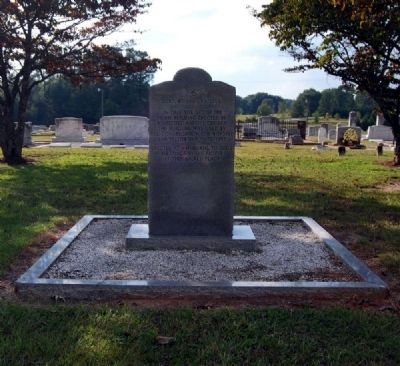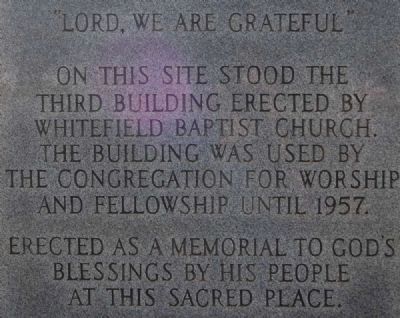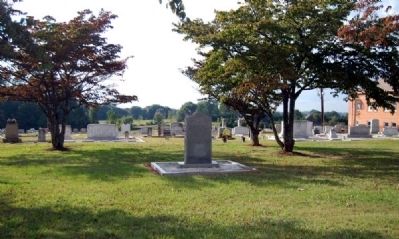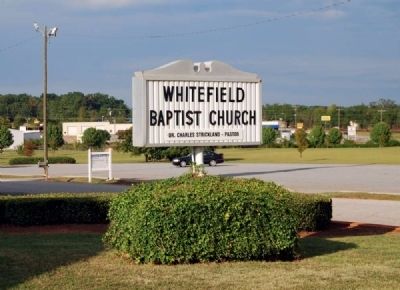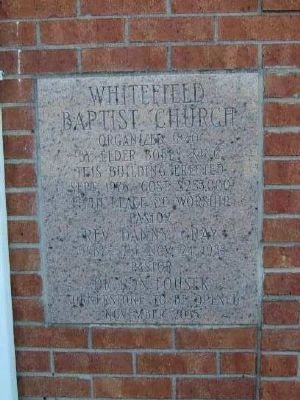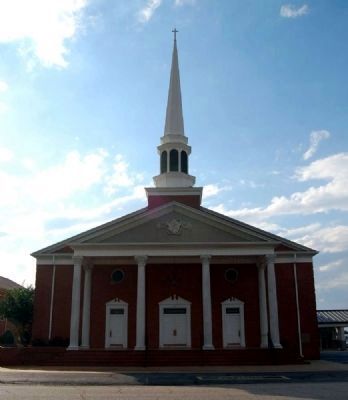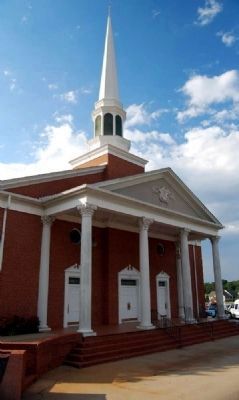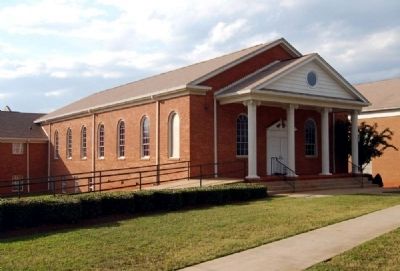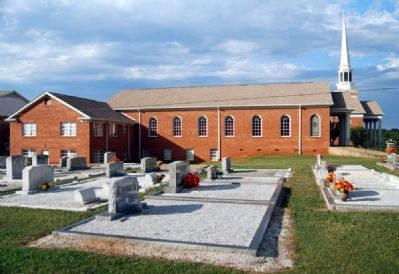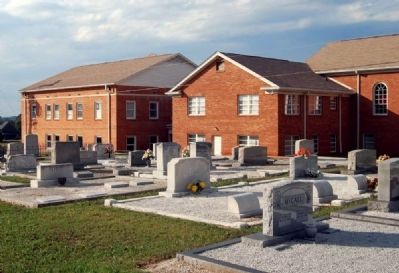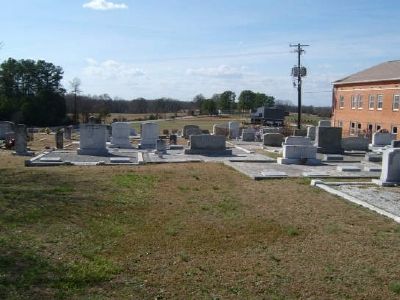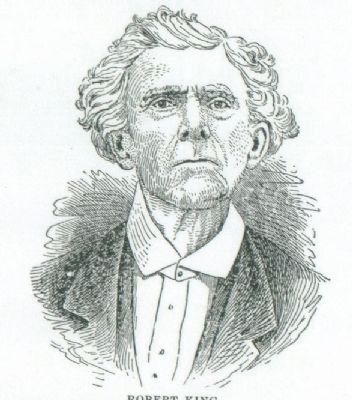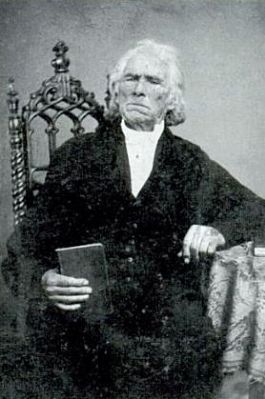Belton in Anderson County, South Carolina — The American South (South Atlantic)
"Lord, We Are Grateful"
On this site stood the third building erected by Whitefield Baptist Church. The building was used by the Congregation for worship and fellowship until 1957.
Erected as a memorial to God's blessings by his people at this sacred place.
Topics. This historical marker is listed in this topic list: Churches & Religion. A significant historical year for this entry is 1957.
Location. 34° 35.167′ N, 82° 33.1′ W. Marker is in Belton, South Carolina, in Anderson County. Marker is at the intersection of Mitchell Road and South Carolina Highway 146, on the left when traveling north on Mitchell Road. Marker is located on the east side of the church cemetery. Touch for map. Marker is at or near this postal address: 207 Mitchell Road, Belton SC 29627, United States of America. Touch for directions.
Other nearby markers. At least 10 other markers are within 5 miles of this marker, measured as the crow flies. Dorchester Baptist Church World War II Veterans Plaque (approx. 3.4 miles away); Hopewell Church (approx. 3.4 miles away); Veterans of All Wars (approx. 3.7 miles away); Old Hopewell Cemetery (approx. 3.8 miles away); Williamston (approx. 4.6 miles away); West Allen Williams (approx. 4.7 miles away); West Allen Williams Memorial Gravesite (approx. 4.7 miles away); Williamston 9-11 Monument (approx. 4.7 miles away); Gist Rifles Monument (approx. 4.7 miles away); Williamston Female College (approx. 4.7 miles away).
Additional commentary.
1. Whitefield Baptist Church
Whitefield Baptist Church is located in Anderson County five miles from Williamston and ten miles from Anderson, just off Highway 29.
Prior to the year 1840 there was a scope of country extending from Dorchester Church on the South, to Hopewell on the North, from Big Creek Church on the East, and to Anderson Court House on the west, embracing an area of 200 square miles, in which there was not a single church or place where the people of this region might attend worship. In going from his home in Belton to his appointment at Hopewell, Elder Robert King had to pass through this destitute section. He looked upon the fields and saw that it was "white to harvest," and began to thrust in his sickle. At first, he preached in homes, but in a short time a house of worship was erected midway between the present location and the old Pendleton Road. The house was built of large pine logs and stood on land now owned by Major G.W. Anderson. Elders Robert King, B.F. Mauldin, D. Simmons, and others continued to preach here for more than ten years before any church was organized.
In 1850 Deacon Asa Garrett, of Rabun's Creek in Laurens County, moved into the neighborhood and duly organized a church at Whitefield Meeting House in the early part of 1851, with eleven members.
Original members were:
Asa Garrett and family
Harvey Cox and family
S. L. Garrett and family Mrs. Sallie Rogers
Asa Cox and family
Elder Robert King served the church as first pastor, and remained as pastor until the end of 1856. Asa Garrett and Asa Cox were the first deacons. Samuel L. Garrett was the first member of the church to be licensed to preach the gospel. This took place in 1854 and Mr. Garrett was immediately ordained as pastor of Whitefield. By the end of the third year the membership had increased from 11 to 63 members.
Mr. Garrett served as pastor through 1857. He was succeeded by James C. Cones and Robert King.
In 1869, the log cabin "house of worship" was replaced by a small frame building on land deeded to the church by Greenlee Ellison. The building was made of rough lumber and was never painted or sealed.
J.J. Campbell served as pastor for a short time in 1873, after which J.M. Lander became pastor. Pastors who followed him included W.P. Martin, W.H. King, E.A. Durham and G.M. Rogers. During the pastorate of the latter a neat and substantial house was built. It was not entirely finished until the spring of 1894 when J.M. Allen became pastor.
The following men served as deacons from the time of organization until the end of 1893: Asa Garrett, Asa Cox, J.T. Stone, Chester Walker, E.M. Ambrose, Greenlee Ellison, Jasper King and D.J. Vanadore.
For the first ten years of this century the following served as pastors: J.M. Allen, H.C, Martin, G.A. Martin, C.H. Holland, R.W. Burts, J. T. Mann, N.G. Wright, D.C. Williams and W.W. Leathers.
In 1913 the present cemetery was surveyed and laid off in plots.
Rev. Leathers served until 1919; Rev. T.L. Hooper succeeded him and he, in turn, was followed by A.D. Canup, J.J. Hiott, E.C. White, J.E. Crawford, Glenn Bolch, E.D. Edwards, and Rev. J.E. Crawford.
Under Rev. Crawford's leadership, the church progressed, it was refurbished with new pews, hardwood floors, venetian blinds, a Hammond organ, pulpit chairs, and a heating' system.
The membership of Whitefield in 1952 was 373. (Source: A Town Springs Forth: The Story of Williamston, South Carolina by Gene Welborn, 2000.)
— Submitted October 6, 2010, by Brian Scott of Anderson, South Carolina.
2. Elder Robert King
THIS remarkable man and eminent minister of the Gospel was born of humble parentage in Anderson county, S.C., the first day of January, 1791.
The society in which he was reared was unfavorable to the development of the mental and moral powers of his youthful mind. He enjoyed no advantages, either educational or religious. At the age of eighteen, being disheartened by the dissipation of his father, he determined, without the counsel or permission of his parents, to seek his fortune among strangers, in a strange land. Accordingly, in the spring of 1809 he went to Dickson County, Tenn., where, in 1810, he professed religion, joined the Turn Bull Church, and was baptized by Elder Daniel White, of that State. Shortly after his conversion he returned to the land of his nativity, and united with the Neal's Creek Church, in Anderson County, S.C. In March of the succeeding year, he found a companion for life in the person of Miss Fannie Holland, daughter of the Rev. Moses Holland, at that time pastor of Neal's Creek Church. Like many other Christians, he became cold and careless, neglected the house of God, a sure indication of a back-sliding condition, and thus he continued, step by step, to decline until May, 1820. When, in his seventy-ninth year, he was asked by an eminent divine if he did not think he might have been deceived as to his conversion in Tennessee, he replied: "I do not think I could have been deceived, from
the fact: If the prodigal son had never been at his father's house he would not have known the way back. I knew I found peace with God through repentance and faith in my blessed Jesus when I was in Tennessee, and, as a backslider, I knew the way to seek and to find him." The minister replied: “This is the best comment I ever heard on the parable of the prodigal son."
Soon after his restoration to the church, his purity, humility and Christian deportment began to attract the attention and admiration of all who knew him. Such confidence was inspired by his piety, that he was frequently called upon to lead worshipping assemblies in prayer. A heaven-born zeal for the salvation of man now warmed up his soul, and he began to lift up his voice, portraying the wondrous love of Jesus. Uncultured as he was, his appeals were touching, powerful, and, in many instances, irresistible. Impressed with the love of Jesus and the value of souls, he now determined to consecrate himself wholly to the work of the ministry. One great obstacle, however, presented itself--he knew not a letter in the alphabet. But so strong was his desire to preach, that he resolved to overcome this barrier. His wife taught him his letters, to spell and to read. The Bible at once became the book for his life-study, and he was emphatically a Bible preacher, drawing from it his faith, doctrines and practice.
On
May 24, 1828, he was ordained at the Neal's Creek Church by Elders James Burriss, Arthur Williams, Sanford Vandiver and Moses Holland. He then became pastor of Washington Church, in Greenville County, S.C., which position he held for eight years. In September 1829, he and Elder William McGee were called jointly to the care of Neal's Creek Church, and during the next year they baptized 160 converts. In 1831, by a petition, he moved his membership to Big Creek Church with a view of becoming its pastor. Here he continued nearly seven years, during the first three or four of which his ministerial labors were most signally blessed, the membership of the church having been increased from fifty-six to 163.
During his ministry at this church his usefulness was completely jeopardized and the spirituality and progress of the church wholly impaired by an anti-missionary party which controlled the church, but the Lord graciously saved His chosen servant from the influence and the errors of that party, for after this until his death he directed his whole energy and influence to the support of missions and other institutions which had for their end the glory of God and the amelioration of suffering humanity.
The predominance of the anti-missionary spirit in the church and his opposition to it made him many enemies, which rendered it necessary to sever his connection with this
church, which took place in August 1838. The loss he sustained in friends by this eruption was great, but God maintained his cause and gave him many strong supporters elsewhere.
On May 3, 1832, he assisted in the constitution of the Dorchester church, becoming its pastor on the same day, which happy relation existed until 1866, a period of thirty-four years. This was his longest pastorate. In 1833 he assisted in the constitution of the Zion Hill Church, in Greenville County, S.C., and accepted a call to its pastorate, which continued for three years. In March of the same year he also assisted in the organization of Poplar Springs Church (now Long Branch). In 1836 he was called to the care of Hopewell Church, which position he filled for sixteen years to the glory of God and the salvation of man. He accepted a call in 1841 to the Lebanon Church, in which capacity he served till 1845. From 1843 to 1846 he served as pastor of the Poplar Springs Church.
In connection with his pastoral duties, he acted for some years about this time as colporter for the Book Depository of the Saluda Association, distributing large numbers of Bibles, Testaments, tracts and other religious books in the destitute portions of the country. He, also, took several extensive evangelistic, or missionary tours through the mountain region of the State, holding meetings and planting churches, in which his labors were wonderfully blessed.
In 1847 he was called to the pastorate of Hepsibah Church, located in the “Fork,” between Seneca and Tugalo rivers, where he labored successfully and acceptably for seven years. He received a call in 1848 to the New Prospect Church, in Anderson county, which he accepted, serving them three years, to the satisfaction and delight of all. In 1852 he assisted in the organization of the church at Whitefield, and on the same day became its pastor, which relation continued until 1872, and as long as he was able to do pastoral work. He assisted in 1850 in constituting a church near Earle's Bridge, on Seneca river, known as the Seneca Church, which has since been changed to Mt. Tabor, and at their request preached for them two years. From 1858 to 1862 he served the church at Neal's Creek, and in 1859 he became pastor of the Mt. Bethel Church which position he held for seven years. In 1870 he took charge of the Mt. Tabor Church, and, so far as we know, this was the last call he ever accepted. In the year 1875 he assisted in the constitution of Cedar Grove Church, near Williamston. This was, perhaps, the last official work he ever done.
The whole life of this faithful servant of God was spent in active work for Jesus. From 1828 to 1872 be was never free from the care of churches, much of the time having had the care
of as many as four. He traveled extensively in the service of the various churches, which he served as pastor; and was a prominent member for many years of the Saluda Association. As a preacher, he was neither eloquent nor profound, but earnest, fearful, evangelical and persuasive. His ministrations were always acceptable to the people. In the preparation and delivery of his sermons he depended entirely upon the Holy Spirit, hence his preaching was always effective. He never staggered at the promises of God; and was always lively and cheerful. His sole object in living and preaching was to win souls to Christ. He ever exhibited in his life the power of Gospel truth, and the preciousness of the hope of salvation through Jesus Christ to sustain the Christian in all life's trials, and to infuse the soul with love and joy. Ho was a ma~ of strong mind and gushing emotions, and labored zealously for the cause of the church to which he was strongly attached.
Brother King raised a family of twelve sons and daughters, all of whom were members of the church he so ardently loved, and were upright and exemplary men and women, making useful and respected citizens in the various walks of life in which they engaged. It was his happy privilege to see two of his sons ordained to the gospel ministry, both of whom made good and useful preachers.
Having finished his course, he died January 1st, 1879, on his 88th birthday. (Source: A History of the Saluda Baptist Association by T.H. Garrett, 1896. Compiled from a biographical sketch prepared by Elder J.S. Murray, and published in The Baptist Courier.)
— Submitted October 6, 2010, by Brian Scott of Anderson, South Carolina.
3. Missionary Zeal
In the 1840s, Rev. Alexander Acker and Rev. Robert King served as missionaries, evangelists for the Domestic Mission Board of the Saluda Baptist Association. They made tours through the mountain region of Oconee, Pickens, and Greenville Counties, distributing bibles and religious literature and holding meetings. One legend says that on this tour in the Long Creek section of northwest South Carolina, the Rev. Bobby King left his newly shined shows on the front porch of the cabin in which he was staying. He had polished his shoes with tallow, or beef fat. The next morning when he went to search for his shows, he found that the dogs had eaten them during the night, so he had to preach his appointed sermon barefoot that day. A person attending the religious meeting took pity on the forlorn gentleman and purchased a pair of shoes to replace those destroyed by the dogs. Later, after spending some time with the grateful minister, the patron was converted to the heavenly fold. (Source: Belton by Alison Ashley Darby (2004) pg 102.)
— Submitted October 6, 2010, by Brian Scott of Anderson, South Carolina.
Credits. This page was last revised on September 26, 2022. It was originally submitted on October 6, 2010, by Brian Scott of Anderson, South Carolina. This page has been viewed 1,775 times since then and 32 times this year. Photos: 1, 2, 3, 4, 5, 6, 7, 8, 9, 10, 11, 12, 13. submitted on October 6, 2010, by Brian Scott of Anderson, South Carolina.
